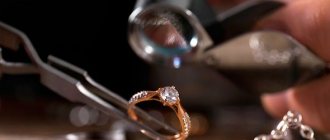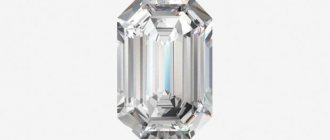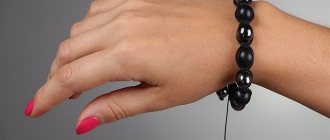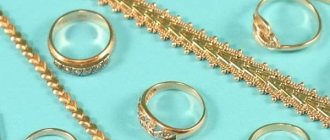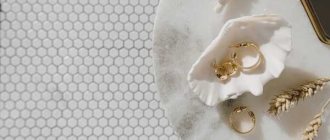In 1966, at the next plenum of the CPSU, it was decided to create mass jewelry production in the USSR, and gradually gold jewelry became available to all Soviet citizens. Surely, in your family there are examples of “Soviet gold” that are difficult to confuse with modern models.
The design of jewelry in those years was influenced, firstly, by the desire to move away from the “bourgeois” aesthetic canons, and secondly, by the successes of Soviet scientists in creating synthetic stones. On the hands and ears of Soviet women there were giant artificial rubies, emeralds, corundums, alexandrites, colorless and colored cubic zirconia.
Is it true that Soviet gold is better?
The most common standard of Soviet gold is 583, the color is red. USSR jewelry is of good quality, made, as they say, to last: without unnecessary grace, but really strong, always quite weighty, with reliable stone settings. In comparison with the low-grade jewelry that came after them from Turkey, the Italian “puffery”, they truly seem monumental. Is Soviet gold really better than modern gold? It depends at what point you compare!
Gold ring with large emerald and diamonds 911025I
Design
If we talk about design, it was not very diverse in the USSR. In 1983, about 500 models of rings with inserts were produced throughout the Soviet Union, and today the Diva assortment alone amounts to 1000 models. Exclusives were created to order, each factory model was replicated in batches of thousands.
Workmanship
Everything Soviet is associated with high reliability, be it earrings or a tank. Today, many people complain that rings bend and earrings break. It should be noted that this is also the fault of the buyer with his desire to save money. The weight of a Soviet wedding ring of 583 standard with a width of 5 mm was about 5 g, but today wedding rings with the same width weighing 1.5 g are offered, i.e. with a very thin wall. When choosing lightweight jewelry, the buyer should be prepared for the fact that they are not intended for regular wear!
Inserts
Not every person from the Soviet Union could buy jewelry with natural stones. Of course, Soviet diamond rings were produced, but they were sold “through connections.” Almost all inserts in jewelry from the times of the USSR are artificial stones, so it’s hard to call them family jewels in the full sense of the word.
Ergonomics
Many models were not particularly comfortable. The fit of wedding rings is straight, for bands wider than 4mm this means cutting the edges into the skin. The earrings are heavy, sometimes with a thickened square pin for reliability.
Sample of Soviet gold
The percentage of precious metal from the USSR is equal to or slightly lower than in modern Russian gold. The composition of alloying additives may differ slightly, but for red gold it is still the same copper and silver; we talked about this in more detail in the article “What are the hallmarks of gold.” Talking about some incredible quality of Soviet-era gold in comparison with modern Russian gold is more about nostalgia than reality.
Shade of gold and purity - is there a connection?
Does the gold standard depend on the shade of the product? Does 585 gold have a red tint? All of these statements are incorrect because the color of gold largely depends on the impurities added to the alloy. Only a subtle shade of the product can be the fact of the presence of pure gold in the total mass of the jewelry product. The myth about the dependence of the shade of jewelry on the percentage of pure gold content became widespread thanks to the Soviet Union. At that time, products made from 750 gold were yellow, 375 were pink, and 585 were red, which was due to the traditions of the jewelry industry in the USSR.
Samples, composition, weight and cost of Soviet gold
The compositions of alloys were fixed in state standards, each shade of the alloy has its own. This is an advantage of the USSR jewelry industry: today's jewelers are required to observe the percentage of precious metal in the product, but they add the ligature “to their taste,” which can affect the wear resistance of the jewelry.
- 375. Soviet gold 375 (9-karat) was used to make watches, cigarette cases, lighters and other household items, as well as the most inexpensive wedding rings and jewelry. According to the 1918 decree, all jewelry could be made exclusively from 36-carat gold (which later changed to 375), and this requirement was observed for many years. In appearance, 375 metal is faded; due to the high content of copper and silver, it becomes coated over time.
- 583. Soviet gold standard 583 is an analogue of the modern 585 with a slightly lower precious metal content, the most used gold alloy in the USSR. Replacement with 585 was necessary to bring it to global standards.
- 750. Soviet gold 750, like today's 750, was used to make jewelry of a higher level, incl. with diamonds and other natural precious stones. The 750 standard on the ring is an indirect confirmation that the ruby in it is real!
- 875. Soviet gold 875 – sometimes we get asked about this too. If a piece of jewelry has a hallmark of 875, and there is a Soviet star next to it, it is 875 silver, possibly in solid gold.
Is it possible to determine the “antiquity” of a piece of jewelry by stamps and hallmarks? For example, when was the Soviet ring with the 63K mark made? It is a mistake to think that 63 is the year of manufacture. In fact, it is the number 6 and the letters ZK. ZK - means “Kostromskaya” - this is 1966 (and if a dot is added to the number 6, then 1976). In order to correctly determine the place of production and year, you need to look at both the assay office code and the name of the jewelry.
Ring with large ruby and diamonds 911025Р
Gold ring with rubies and diamonds 911011Р
The current value of Soviet gold
Despite the popular belief that precious metal with USSR hallmark is better than modern metal, this does not increase its price. How much Soviet 583 gold costs depends on the weight of the product without inserts. When taking it to a pawnshop, you can rely on the price offered for the 585 sample. You can sell your “batch gold” at the same price as any other gold of the same standard.
Features of alloys
What does the amount of metal in an alloy practically mean? First of all, this affects the physical characteristics of the material. For example, 999 gold is very soft, making earrings or rings from it is difficult. But the famous 585 is quite suitable, since the nickel, zinc and copper included in it give the alloy much greater strength and resistance to wear.
Samples of the USSR
The weight ratio affects the color. Moreover, not only quantitative, but also qualitative relationships are important here. Thus, the addition of copper to an alloy marked 585 will give the product a reddish tint, and the addition of zinc will turn the alloy white. Silver in large quantities 23.4 by 585 will give the alloy a greenish tint.
The table of gold samples in the USSR indicates quantitative data, but you should learn more about qualitative data.
| Metal | Try |
| Gold | 375, 500, 583, 585, 750, 916, 958, 999 |
| Silver | 800, 830, 875, 925, 960, 999 |
| Platinum | 585, 850, 900, 950 |
| Palladium | 500, 850 |
What information can be obtained by looking at the data in the table?
- 375 - means the presence of 38% pure metal in the alloy. Products made from it are yellow in color, but fade quite quickly, since iron sylphide appears on its surface.
- 500 – the color range varies very widely, since 50% of gold is a mixture of silver and copper and it is their ratio that gives the color.
- 585 - over time replaced 583. They differ little in color and physical characteristics - 58.3% versus 58.5%, but the first value did not meet European standards and, in the end, ceased to be used. Earrings made of 583 USSR gold, as well as rings, brooches and other jewelry are the most popular “investment” of money. Spav is very stable, durable, and does not lose color or shine under any conditions.
Vintage jewelry to create original looks
Soviet gold jewelry from the USSR era is a range of memorable designs that can be used in modern looks! Such models are likely to be found in almost every family, which does not reduce their merits! How to wear Soviet jewelry today?
- “Raspberries” are colored stones surrounded by a circle of colorless ones. Earrings and rings “raspberries” are a variant of the “halo”; this arrangement of inserts remains a hit to this day. The advantages of “raspberries” are that even a small central stone in them looks luxurious due to the surrounding of small crystals. You can wear the Soviet “raspberry” in any elegant look; such models still look relevant today.
- “Tulips” - a large or medium-sized stone is sandwiched in a golden “tulip” of pronged petals. “Tulip” was used for earrings, rings and even watches. The insert seems to float in them, it is clearly visible from all sides, and the mount itself is very decorative. Today, “tulips” are hardly made because if you use a real gemstone, they would cost a fortune. You can use the laconic “tulips” that you inherited in business looks with a retro touch.
- “Sudarushki” are patterned (openwork or embossed) Soviet earrings made of gold in the form of an inverted kokoshnik, usually without inserts. They contain Slavic motifs, and this is a wonderful detail to the ethno-image.
- Turban rings are large rings without inserts with a flared front part and a rounded shape. Fits perfectly into the oversized trend!
- The “Shakhin” ring is a real hit of the USSR, the dream of every Soviet woman! The ring was decorated with a huge oblong stone set in a wide openwork base, tapering towards the back of the product. Now such a ring can be worn by girls who are no strangers to self-irony, because the fact that the stone is artificial is obvious. “Shakhinya” fits well into the mix of rings, becoming its accent.
Spool sampling system
This assessment system was widely used in Russia and the USSR until 1927. It differs from carat in that the highest standard of gold has a value of 96 units, and all kinds of alloys in Russia had correspondingly lower numerical values. The system works on the same principles as others - the higher the precious metal content, the higher the sample number. When transferring from such a system to others, a special table is useful.
Different countries prefer different types of alloys, which depends on the standard of living and understanding of the practicality of citizens. Thus, in the USSR the most popular jewelry was made from 583rd standard.
Now in Europe, products made from 750-carat gold are popular, as are wealthy people in Russia. Well, in Germany, for example, the smallest sample size is 333 marking.
In Arab countries, in the Gulf countries, as well as in Bangladesh, India, Pakistan and Sri Lanka, 875-990 samples are preferred. In the karate system, this corresponds to indicators 21-24.
Next come Europe and Egypt, where they love 750-carat gold (18 carats), but Portugal stands out from the general row with its love for 800-carat gold (19.2 carats). In Ukraine, Russia and other countries of the former USSR, the 583rd and 585th samples (14 carats) are more popular due to their good gold content and relatively reasonable price.
The most unpretentious people towards precious metal live in northern Europe and the USA. They can wear either the lowest standard - 333, or 750 (8-18 carats), but in these countries gold is not considered an indicator of status and products made from it are used precisely as a beautiful accessory.
Care Tips
Despite the quality and reliability of the jewelry, it tends to darken due to the ligature contained in the composition. When in contact with the human body and oxygen, gold will change; to prevent this from happening, the following actions can be included in preventive measures:
- you need to add up to 5 drops of ammonia to a glass of soap solution,
- decorations are placed in water for 20 minutes,
- Having taken out the product, rinse it with ordinary tap water,
- Depending on the contamination, you need to either clean the jewelry with a soft brush or simply wipe it with a napkin until it shines.
Important! Such a product should not be exposed to aggressive substances in the form of acids and alkalis, which may be contained in household chemicals. This may ruin the appearance, making it impossible to restore the earrings or rings.
Stamps on products before 1927
In 1899, a new mark for products made of precious metals appeared in Russia in the form of a profile of a woman’s head turned to the left. Next to the stamp, letters were required to indicate the initials of the corresponding assay district, as well as the value of the spool assay in Arabic numerals.
However, already in 1908, after the First Russian Revolution, further changes appeared in the appearance of the mark. First of all, this was caused by the need to gradually switch to international standards. True, in 1908, all the changes boiled down to the fact that the female profile on the brand turned to the right. The sampling system remained spool-type.
